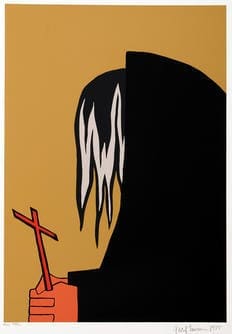The Legend of John Brown
Judith Bear Isroff Gallery
October 16, 2009 - February 14, 2010
*Click here to listen to Curator of Exhibitions Ellen Rudolph's interview
with WKSU's Vivian Goodman*This fall marks the 150th anniversaries of John Brown’s anti-slavery raid on Harper’s Ferry, Virginia, and his December 2, 1859 execution. To commemorate this famous Akron resident, the Akron Art Museum presents selections from Jacob Lawrence’s celebrated print series The Legend of John Brown. Lawrence, one of the most significant American artists of the 20th century, was also the first African American to depict the story of the controversial white abolitionist.
Lawrence's screenprints, which are owned by the museum, will be joined by related images and artifacts from the Summit County Historical Society and the Akron-Summit County Public Library Special Collections Division. A Northerner, Brown (1800-1859) worked on farms in Northeast Ohio before moving in 1844 into a two-room cottage across from the mansion of Simon Perkins, Jr., for whom he worked in the wool trade. Brown's religious convictions led him to oppose slavery. He regularly housed slaves moving through the Underground Railroad in his Akron home. Now part of the Summit County Historical Society, it houses a permanent display about Brown's life.
In contrast with the northern pacifist attitude, Brown believed that militant actions were the only way to end slavery. In the mid-1850s, he organized covert attacks in an attempt to liberate slaves and bring down the pro-slavery establishment. In 1859, with a company of 21 men - white and black - he led a raid on the federal armory at Harpers Ferry, Virginia. He was captured and hanged for treason. While historians agree that Brown's actions helped spark the Civil War, his dogged determination and the violence of his methods have been hailed as both heroic and foolhardy.
Jacob Lawrence's screenprints frame the story as a narrative. Each image presents a specific incident in Brown's dramatic life. Rather than depicting these events in a realistic manner, Lawrence tells the story using sparse details rendered with simplified forms and vibrant colors, which heightens each scene's emotion.
Lawrence (1917-2000), who lived in New York City during the Harlem Renaissance, was the first African American artist to be included in the collection of the Museum of Modern Art, New York. He was a storyteller who used the visual arts to interpret and disseminate important events in American history. His prominence as an artist undoubtedly helped perpetuate the remarkable story of John Brown's life as an abolitionist.
This exhibition is organized by the Akron Art Museum and supported by a gift from Akron General.

